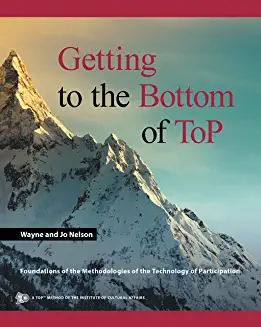Content of the Facilitation Methods Collection
Providing individuals and groups with methods for deepening reflection and enhancing participation
HIGHLIGHT
TECHNOLOGY OF PARTICIPATON METHODS
A video of ToP Focused Conversation and Consensus Workshop Methods
A 17-minute AI NotebookLM on the “Evolution of ICA’s Facilitation Methods”
AI source: Brian Stanfield, June 25, 2005
Group Facilitation Methods
The Technology Of Participation (Top)®
Group Facilitation methods and processes are intended to help groups and organizations move from where they are to where they want to be. The Facilitation Collection contains contextual frameworks, procedures and approaches developed by EI/ICA in the field over more than 50 years. For those who would like an in-depth summary—a master source for the foundations and application of these methods—refer to Getting to the Bottom of ToPby Wayne and Jo Nelson. Order Getting to the Bottom of ToP from iUniverse. To see reviews of the book, click here.
Where did these methods come from?
The methods were forged out of the study and deep collaborative wrestling and experimentation of Institute staff and colleagues around the world. They wrestled to embody a style of responsible human living appropriate to the challenges and opportunities of their era. Collaborating in this way was a major laboratory for the Institute.These individuals were passionate about enabling others to experience and benefit from the stew pot of creativity coming out of the post WWII era. See also The Evolution of ICA’s Facilitation Methods, by Brian Stanfield.

HISTORY: ICA METHODS DEVELOPMENT & PRACTICE
ICA methods grew out of working with individuals, communities and organizations enabling them to take active roles in making informed decisions and creating effective actions.
REFLECTION: CONVERSATIONS & REFLECTIVE PRACTICES
Methods were created for sharing, understanding, and relating to experiences as a way to broaden and deepen individual and group work.
ACTION: METHODS FOR EFFECTIVE ACTION
Group processes were created to help people work effectively across the cultural, political, economic, and social dynamics of society regardless of the societal level, presumed sophistication, financial status, or education of the individuals involved.
MASTERY: PREPARATION & STYLE
Facilitation as a profession, as a practice, as a discipline, is much more than having a set of effective methods and processes. Excellent facilitation requires mastery on several levels.
RESOURCES: FURTHER EXPLORATIONS
In addition to the resources in this section, additional resources are mentioned throughout the website.
A facilitator is one who makes it easy
for others to perform their tasks.
Simply speaking, the facilitator thinks through procedures
and formats that enable a group
– to gather its cumulative insights
– to order them -and then
-to decide on a course of action that has consensus and commitment backing it.
John Epps, Master Facilitator
